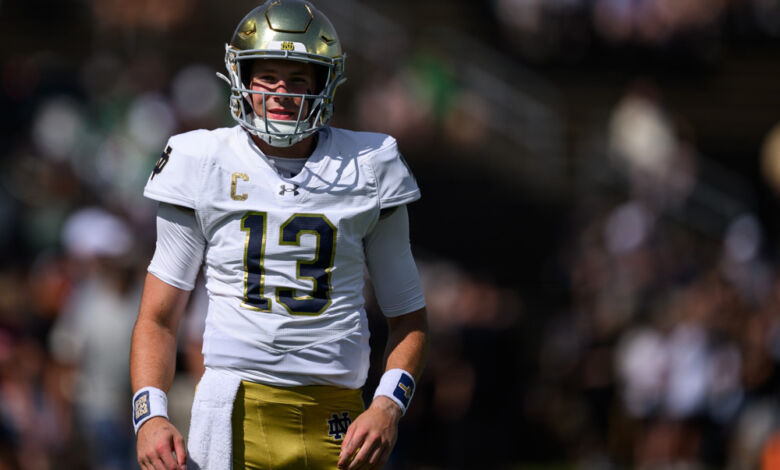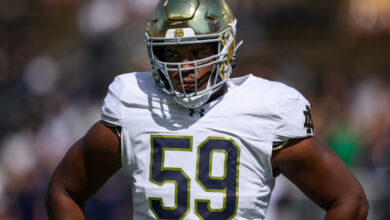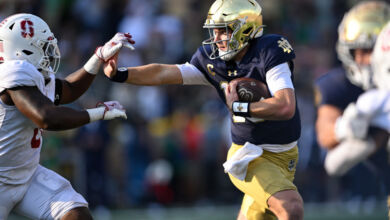
Getting a read on how both Notre Dame and Miami of Ohio will perform on Saturday can cause some head-scratching moments. Especially because the Irish’s once-invincible halo against MAC teams ended after the loss to Northern Illinois. Below are some comparative numbers to ponder:
Leonard in Context
Riley Leonard was brought to contend for a national title, with the expectation being that his passing skills and running ability could be used in tandem. After three games this season, it’s been Leonard’s running that’s seemingly gotten more recognition. Thus far, Leonard has 433 passing yards but no touchdown passes and two interceptions. As a runner, he’s picked up 179 yards and scored four times
On those runs, Leonard is averaging 5.3 yards per carry and is a threat once he decides to take off. One potential reason why the passing numbers haven’t made much of an impact is because the top two reception leaders, Beaux Collins and Jaden Greathouse have accounted for over 35 percent of the catches. Establishing better chemistry with the other options may help even out those numbers.
When it comes to mobile Notre Dame starting quarterbacks like Leonard, there are four that stand out over the past decade-plus. In 2012 and 2014, Everett Golston gained close to 300 rushing yards in each season, a number Leonard should easily surpass. In 2015 and 2016, DeShone Kizer finished with 992 yards combined for his rushing total.
In 2017, Brandon Wimbush led an Irish resurgence in which his passing was effective enough with 16 scoring tosses and just six pickoffs. However, he excelled on the run with 803 yards and 14 scores. The following year, he started the first four games and gained 256 rushing yards. He was then replaced by Ian Book, who never looked back. Having experienced both good and bad seasons with this type of signal-caller, the jury’s still out on how things will play out.
Notre Dame Defense Rolls On
Two standout performances sandwiched around an uneven effort in the loss to Northern Illinois give Notre Dame some hope that it can prove the adage that defense wins championships. Even in that stunning defeat, Irish defenders only allowed their opponents a single touchdown, an accomplishment that was also achieved in the two wins.
Looking at key defensive numbers after three games during the three seasons under Marcus Freeman, Notre Dame has seen some numbers dip while sacks have risen by one since over the same time frame from last year. The most prominent decline has been in the area of quarterback hurries, with nine so far in 2024. In 2023, the number was a notable 18, though that was somewhat skewed by picking up 10 in the rout of an FCS team, Tennessee State. Freeman’s slow start in 2022 saw the Irish with just six in this category after a trio of contests.
When it comes to tackles-for-loss (TFL), interceptions and pass breakups, there’s been a slight decline from last year’s numbers at this point. However, it’s a negligible amount, with 11 TFL’s, compared to 13 in 2023 and 18 the year before. Interceptions have decreased by only one pickoff, five to four. Still, the current amount is infinitely better than the zero that Notre Dame had in 2022. For pass breakups, they’re down from 12 to 10 since last season’s first three games, though this year’s number is still twice as much as the five in 2022.
Finally, the Irish defense has only forced a pair of fumbles, in contrast to five at this point last season. Two years ago, this unit was still looking for its first turnover in this department. One frustrating constant continues in that among the seven total forced fumbles in this period, Notre Dame has yet to recover any of the opposing miscues.
Miami of Ohio Year-to-Year
After two games this year, the RedHawks’ offense this season has strongly focused on the passing game, gaining 583 yards in their passing attack and just 64 through the ground game. Last season, Miami still relied heavily on the pass, throwing for 466 yards while rushing for only 195. Quarterback Brett Gabbert has had more struggles this season with two touchdowns and three interceptions, compared to four touchdown tosses and two picks after the first two games of 2023.
The Redhawk pass defense has managed to improve compared to last season’s first two games, allowing only 364 yards compared to 487 at this point last year. In addition, after allowing four touchdown passes in that time frame in 2023, Miami has only allowed one scoring toss. The Redhawks are still looking for their first pickoff after collecting two after last season’s first two matchups. The struggles to stop opposing runners continue with 365 yards allowed this season, compared to 312 at the same point last year.



